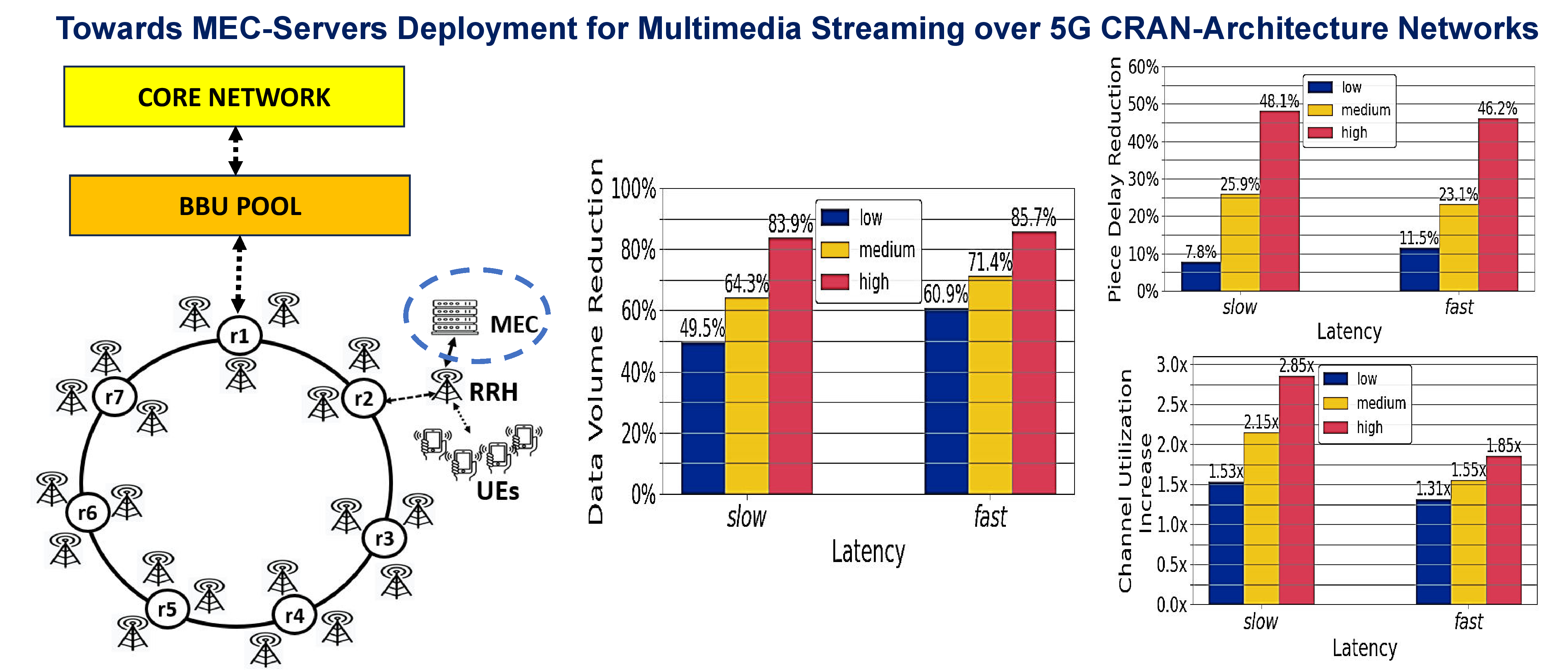Towards MEC-Servers Deployment for Multimedia Streaming over 5G CRAN-Architecture Networks
Keywords:
5G networks, MEC, Streaming, MultimediaAbstract
This article evaluates MEC-servers deployment for multimedia on-demand streaming service over 5G cellular networks. The experiments are based on simulations within a CRAN architecture. Three performance metrics are assessed: operational download, piece delay, and channel utilization. Overall, the experiments reveal substantial effectiveness, enhancing QoS and QoE levels. Among the main findings, we highlight that: (i) for a storage capacity of only 5% of the content providers’, MEC-servers deployment reduces data volume on the network by up to 85.7%, whereas (ii) for a storage capacity of 30%, all three metrics above reach their most optimized operating values, regardless of video popularity and network latencies. As its main contribution, this research thus provides valuable insights into the evolving landscape of streaming-service projects in 5G cellular networks equipped with MEC servers. At last, conclusions and future work conclude this article.
Downloads
References
Y. Li, H. Ma, L. Wang, S. Mao, and G. Wang, “Optimized Content Caching and User Association for Edge Computing in Densely Deployed Heterogeneous Networks,” IEEE Transactions on Mobile Computing, vol. 21, no. 6, pp. 2130–2142, 2022. doi:10.1109/TMC.2020.3033563.
P. Lin, Z. Ning, Z. Zhang, Y. Liu, F. R. Yu, and V. C. M. Leung, “Joint Optimization of Preference-Aware Caching and Content Migration in Cost-Efficient Mobile Edge Networks,” IEEE Transactions on Wireless Communications, vol. 23, no. 5, pp. 4918–4931, 2024. doi:10.1109/TWC.2023.3323464.
D. Xenakis, A. Tsiota, and N. Passas, “Admission control and end-to-end slicing for video streaming in MEC-empowered cellular networks,” in GLOBECOM 2022 - 2022 IEEE Global Communications Conference, pp. 3423–3428, 2022. doi:10.1109/GLOBECOM48099.2022.10001504.
J. Aguilar-Armijo, C. Timmerer, and H. Hellwagner, “SPACE:Segment Prefetching and Caching at the Edge for Adaptive Video Streaming,” IEEE Access, vol. 11, pp. 21783–21798, 2023.
doi:10.1109/ACCESS.2023.3252365.
A. Sarah, G. Nencioni, and M. M. I. Khan, “Resource Allocation in Multi-access Edge Computing for 5G-and-beyond networks,” Computer Networks, vol. 227, p. 109720, 2023. doi:10.1016/j.comnet.2023.109720.
B. Liang, M. A. Gregory, and S. Li, “Multi-access edge computing fundamentals, services, enablers and challenges: A complete survey,” Journal of Network and Computer Applications, vol. 199, p. 103308, 2022. doi:10.1016/j.jnca.2021.103308.
Y. Chen, Y. Cai, H. Zheng, J. Hu, and J. Li, “Cooperative caching for scalable video coding using value-decomposed dimensional networks,” China Communications, vol. 19, no. 9, pp. 146–161, 2022.
doi:10.23919/JCC.2022.00.006.
M. Pattaranantakul, C. Vorakulpipat, and T. Takahashi, “Service Function Chaining security survey: Addressing security challenges and threats,” Computer Networks, vol. 221, p. 109484, 2023.
doi:10.1016/j.comnet.2022.109484.
F. Zanferrari Morais, C. André da Costa, A. M. Alberti, C. Bonato Both, and R. da Rosa Righi, “When SDN meets C-RAN: A survey exploring multi-point coordination, interference, and performance,” Journal of Network and Computer Applications, vol. 162, p. 102655, 2020. doi:10.1016/j.jnca.2020.102655.
R. T. Rodoshi, T. Kim, and W. Choi, “Fuzzy Logic and Accelerated Reinforcement Learning-Based User Association for Dense C-RANs,” IEEE Access, vol. 9, pp. 117910–117924, 2021.
doi:10.1109/ACCESS.2021.3107325.
L. B. Silveira, H. C. de Resende, C. B. Both, J. M. Marquez-Barja, B. Silvestre, and K. V. Cardoso, “Tutorial on communication between access networks and the 5G core,” Computer Networks, vol. 216,
p. 109301, 2022. doi:10.1016/j.comnet.2022.109301.
V. S. Pana, O. P. Babalola, and V. Balyan, “5G radio access networks: A survey,” Array, vol. 14, p. 100170, 2022. doi:10.1016/j.array.2022.100170.
G. Minopoulos, K. E. Psannis, G. Kokkonis, and Y. Ishibashi, “QoE Assessment of Video Codecs for Video Streaming over 5G Networks,” in 2020 3rd World Symposium on Communication Engineering (WSCE), pp. 34–38, 2020. doi:10.1109/WSCE51339.2020.9275576.
A. Kulkarni and A. Seetharam, “QoE-aware Video Streaming in Heterogeneous Cellular Networks,” in 2021 IEEE 18th Annual Consumer Communications & Networking Conference (CCNC), pp. 1–2, 2021.
doi:10.1109/CCNC49032.2021.9369556.
T. M. Ayenew, D. Xenakis, N. Passas, and L. Merakos, “Cooperative Content Caching in MEC-Enabled Heterogeneous Cellular Networks,” IEEE Access, vol. 9, pp. 98883–98903, 2021.
doi:10.1109/ACCESS.2021.3095356.
J. Yu, H. Wen, G. Pan, S. Zhang, X. Chen, and S. Xu, “Quality of Experience Oriented Adaptive Video Streaming for Edge Assisted Cellular Networks,” IEEE Wireless Communications Letters, vol. 11,
no. 11, pp. 2305–2309, 2022. doi:10.1109/LWC.2022.3200830.
A. L. S. de Moraes, D. D. de Macedo, and L. Pioli, “Video streaming on fog and edge computing layers: A systematic mapping study,” Internet of Things, vol. 28, p. 101359, 2024. doi:10.1016/j.iot.2024.101359.
N.-N. Dao, N. H. Tu, T.-D. Hoang, T.-H. Nguyen, L. V. Nguyen, K. Lee, and Laihyuk, “A review on new technologies in 3GPP standards for 5G access and beyond,” Computer Networks, vol. 245, p. 110370, 2024. doi:10.1016/j.comnet.2024.110370.
A. Montresor and M. Jelasity, “PeerSim: A scalable P2P simulator,” in 2009 IEEE Ninth International Conference on Peer-to-Peer Computing, pp. 99–100, 2009. doi:10.1109/P2P.2009.5284506.
N. Molner, A. de la Oliva, I. Stavrakakis, and A. Azcorra, “Optimization of an integrated fronthaul/backhaul network under path and delay constraints,” Ad Hoc Networks, vol. 83, pp. 41–54, 2019. doi:10.1016/j.adhoc.2018.08.025.
B. Naudts, M. Kind, S. Verbrugge, D. Colle, and M. Pickavet, “How can a mobile service provider reduce costs with software-defined networking?,” International Journal of Network Management, vol. 26, no. 1, pp. 56–72, 2016. doi:10.1002/nem.1919.
WIKIPÉDIA, “Morumbi (distrito de São Paulo),” 2023. [ONLINE]. Available at:
https://pt.wikipedia.org/wiki/Morumbi_(distrito_de_Sao_Paulo). Accessed on: May 5th, 2024.
A. Narayanan, E. Ramadan, J. Carpenter, Q. Liu, Y. Liu, F. Qian, and Z.-L. Zhang, “A First Look at Commercial 5G Performance on Smartphones,” in Proceedings of The Web Conference 2020, p. 894–905, 2020. doi:10.1145/3366423.3380169.
J. Stoll, “Countries with most content available on netflix worldwide as of march 2023.” White Paper, 2023. [ONLINE]. Available at: https://www.statista.com/statistics/1013571/netflix-library-sizeworldwide/. Accessed on: May 5th, 2024.
USP, “Nove em cada dez indivíduos utilizam o celular para acessar a internet em São Paulo.” Jornal da USP, 2023. [ONLINE]. Available at: https://jornal.usp.br/radio-usp/nove-em-cada-10-individuos-utilizamo-celular-para-acessar-a-internet-em-sao-paulo/. Accessed on: May 5th, 2024.
T. Wang, C. Jayasundara, M. Zukerman, A. Nirmalathas, E. Wong, C. Ranaweera, C. Xing, and B. Moran, “Estimating Video Popularity From Past Request Arrival Times in a VoD System,” IEEE Access, vol. 8, pp. 19934–19947, 2020. doi:10.1109/ACCESS.2020.2966495. [27] YouTube Help, “Choose live encoder settings, bitrates, and resolutions,” 2021. [ONLINE]. Available at: https://support.google.com/youtube/answer/2853702. Accessed on: May 5th, 2024.
YouTube Help, “Choose live encoder settings, bitrates, and resolutions,” 2021. [ONLINE]. Available at: https://support.google.com/youtube/answer/2853702. Accessed on: May 5th, 2024.


